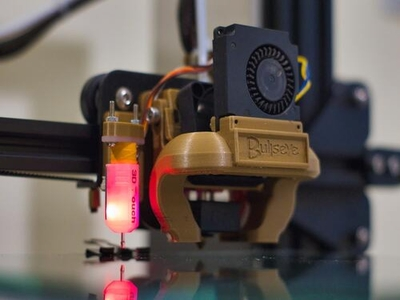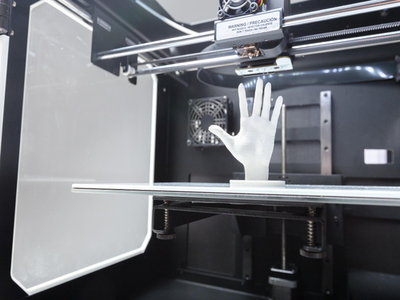If you’re not sure how to dispose of 3D printer resin properly, you’re in the right place.
To dispose of 3D printer resin, throw it in the garbage only after curing it. It should never be poured down a drain. Always wear personal protective gear when handling resin.
We’ll thoroughly discuss safety measures that should be followed while working with resin, how to store it, and, how to get rid of it properly in this guide.
how to dispose of 3D printer resin

Although all of the safety measures we will discuss below are still necessary, eco-friendly resins are considerably less dangerous to you and the environment than standard ones.
NOTE: Always follow the manufacturer’s recommendations for use and disposal.
Safety
When working with resin, always use safety gloves as resins can irritate your skin and cause burns.
In most situations, latex and nitrile gloves should be available to you.
The latter is superior for resin handling since they are chemical resistant and will prevent any resin from coming into contact with your bare hands.
Eye protection is also recommended to protect you from splashes, and since they are readily available, there is no reason not to use them.
You may also utilize a face mask or shield to keep any resin particles out of your lungs and off of your face.
Storage
When not in use, it is critical to store resin correctly.
Because resins are easily affected by UV light, black, light-proof containers are the preferred method of storage.
It is also suggested that the containers be kept in a shaded location, ideally kept in a cabinet or a dark area.
During Printing
It is easy to keep your resin safe before and throughout the printing process.
The thing of paramount importance is to ensure that you consider the dangers of 3D printing and that you’re wearing your gloves while initially pouring resin into the tank or adding resin during the production process.
When it comes to pouring resin, spills are possible.
Regardless of whether or not you have the appropriate equipment to clean it up, it isn’t that big of a deal in the end.
But to ensure that all of your spilled resin is properly removed, clean the vat and the building platform with isopropyl alcohol.
It is recommended that you make sure you have isopropyl alcohol on hand before you begin working with resin. The bigger the bottle the better.
After Printing

The post-printing phase includes removing your print from the build platform, cleaning the vat and build platform, and pouring the resin back into its container.
After your print is finished, we recommend laying some paper towels around the printer to keep the resin off of the surface you’re working on.
Of course, when removing the build platform from the printer, use gloves and alcohol to clean it.
We won’t go through the procedure for post-processing since it’s beyond the scope of this post, and while it may seem a tad difficult due to all the pieces, it is a critical step.
Water-Washable Resin
Resins that can be washed away are referred to as water-washable resins and make it easier to clean 3D printed resin parts.
However, water-washable resins leave behind residual rinse water that contains chemicals that are both dangerous for you and the environment.
Any residual resin in the water must be cured before it is disposed of, something we will go through in greater detail below.
Clean Up
When preserving a print, the vat is usually filled with a residual resin that can be reused.
Make sure you return the residual resin to its container by opening the container, inserting a funnel into the spout, and preferably using a mesh filter.
Then, remove the cap from the container and slowly pour the uncured resin from the tank or tube back into it until it is empty.
After that, use alcohol-soaked paper towels to wipe out any remaining uncured resin, making sure not to scratch it when wiping the FEP film.
Curing
Curing is critical when it comes to resin disposal, so let us look at what it is and how to do it.
When you buy resin, it arrives in an uncured (liquid) state, which is great for printing but also dangerous!
Fortunately, curing is easy and involves heating the resin or exposing it to sunshine (or another source of UV light) until it is completely solidified.
While the uncured resin is unsafe, the cured resin is safe.
When you have finished printing, your gloves and paper towels will be coated with resin.
If possible, place your gloves and paper towels in the sun to cure any remaining resin so you can dispose of it like regular trash.
Read More: Can You Over Cure 3D Resin Prints? Here’s how to cure resin the right way!
Disposal
If you would like to get rid of a failed print, you must still cure it first.
Because the resin is no longer harmful once cured, the components can be handled without gloves and disposed of with regular garbage.
Containers that are empty or have any liquid residue in them should also be avoided.
Always allow the resin to harden before disposing of it by simply opening the containers and leaving them in direct sunlight or a warm place until they are completely dry.
Dos & Dont’s
Here is a short “Dos and Don’ts” list to ensure you are handling your resin appropriately.
Do:
- Wear gloves and goggles throughout your 3D printing project.
- Clean unused prints, cleaning supplies, gloves, or resin containers before throwing them into the garbage.
- Inform your local waste or recycling facility of resin before you drop it off.
Read More: Can You Recycle Failed 3D Prints? Here are more ways to recycle resin!
Don’t:
- Forget your gloves when handling resin.
- Pour uncured resin down the drain for easier cleanup.
- Throw away uncured resin.
- Forget to clean up any spills.
The informative video below gives 11 tips on how to handle SLA resin in particular so that you can print quality projects while also staying safe:
resin Printing Overview
The most common material for stereolithography (SLA) 3D printing is polyurethane.
With SLA, the shape of an item is traced onto the surface of a photopolymer vat using a UV laser.
After that, the resin cures and creates layers in the print, and the process is repeated until it’s a complete 3D print.
There are several key differences between resin 3D printing vs Injection Molding, including the particular qualities of resin.
Resins used in 3D manufacturing have contaminants and must be handled, stored, and disposed of safely.
Not surprisingly, the toxicity of resins makes the whole disposal process more challenging than it is with FDM or polyester filaments.
There are several different types of resin to choose from, but if you’re concerned about the toxicity of resins, an eco-friendly resin might be a better option.
These resins are usually made from biological materials and (in theory) biodegradable.
3Dresyns, for example, are notable for these kinds of bio-based resins.